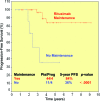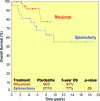Treatment of splenic marginal zone lymphoma with rituximab monotherapy: progress report and comparison with splenectomy
- PMID: 23345547
- PMCID: PMC3579603
- DOI: 10.1634/theoncologist.2012-0251
Treatment of splenic marginal zone lymphoma with rituximab monotherapy: progress report and comparison with splenectomy
Abstract
Background: Treatment of splenic marginal zone lymphoma (SMZL) patients is not standardized. Recent data suggest that rituximab is highly effective and could be considered as initial therapy.
Aim: To assess the efficacy of rituximab monotherapy in a large series of patients with SMZL and compare these results with splenectomy results.
Methods: The studied population included 85 patients. Fifty-eight received rituximab at a dose of 375 mg/m2 per week for 6 weeks as induction followed by maintenance at the same dose every 2 months for 1-2 years, whereas 27 patients were treated using splenectomy only.
Results: The overall response rate to rituximab 2 months after the end of induction was 95% (complete response [CR], 45%; unconfirmed CR, 26%; partial response, 24%). The median times to hematologic and clinical response were 2 weeks and 3 weeks, respectively. Forty-three of 55 patients already completed the maintenance phase: 28 sustained their initial response, 14 improved their response, and one progressed. Eighty-five percent of splenectomized patients responded, and two were treated with rituximab as consolidation after splenectomy and achieved a CR. The 5-year overall and progression-free survival (PFS) rates for rituximab-treated and splenectomized patients were 92% and 77% (p = .09) and 73% and 58% (p = .06), respectively. Furthermore, maintenance therapy with rituximab resulted in a longer duration of response (at 5 years, PFS was 84% for patients receiving maintenance and 36% for patients without maintenance, p <.0001).
Conclusions: Rituximab is a very effective and well-tolerated therapy and may be substituted for splenectomy as the first-line treatment of choice for patients with SMZL.
Conflict of interest statement
Disclosures of potential conflicts of interest may be found at the end of this article.
Figures



Similar articles
-
Comparative outcomes of rituximab-based systemic therapy and splenectomy in splenic marginal zone lymphoma.Ann Hematol. 2014 Mar;93(3):449-58. doi: 10.1007/s00277-013-1900-4. Epub 2013 Sep 22. Ann Hematol. 2014. PMID: 24057925
-
Significant efficacy of 2-chlorodeoxyadenosine{+/-} rituximab in the treatment of splenic marginal zone lymphoma (SMZL): extended follow-up.Ann Oncol. 2013 Sep;24(9):2434-8. doi: 10.1093/annonc/mdt181. Epub 2013 May 26. Ann Oncol. 2013. PMID: 23712547
-
Rituximab, used alone or in combination, is superior to other treatment modalities in splenic marginal zone lymphoma.Br J Haematol. 2012 Nov;159(3):322-8. doi: 10.1111/bjh.12036. Epub 2012 Sep 27. Br J Haematol. 2012. PMID: 23016878
-
Treatment of splenic marginal zone lymphoma: splenectomy versus rituximab.Semin Hematol. 2010 Apr;47(2):143-7. doi: 10.1053/j.seminhematol.2010.01.004. Semin Hematol. 2010. PMID: 20350661 Review.
-
Should rituximab replace splenectomy in the management of splenic marginal zone lymphoma?Best Pract Res Clin Haematol. 2018 Mar;31(1):65-72. doi: 10.1016/j.beha.2017.10.011. Epub 2017 Nov 7. Best Pract Res Clin Haematol. 2018. PMID: 29452668 Review.
Cited by
-
Immunochemotherapy and Maintenance With Obinutuzumab or Rituximab in Patients With Previously Untreated Marginal Zone Lymphoma in the Randomized GALLIUM Trial.Hemasphere. 2022 Feb 24;6(3):e699. doi: 10.1097/HS9.0000000000000699. eCollection 2022 Mar. Hemasphere. 2022. PMID: 35233508 Free PMC article.
-
Incidental Splenic Marginal Zone Lymphoma With Extreme Macrocytosis After Hydroxyurea Use: A Case Report.Cureus. 2023 Jan 6;15(1):e33462. doi: 10.7759/cureus.33462. eCollection 2023 Jan. Cureus. 2023. PMID: 36751210 Free PMC article.
-
Management of Marginal Zone Lymphoma: A Canadian Perspective.Curr Oncol. 2023 Feb 1;30(2):1745-1759. doi: 10.3390/curroncol30020135. Curr Oncol. 2023. PMID: 36826096 Free PMC article. Review.
-
A Rare Case of Factor VII Inhibitor in a Patient Presenting with Primary Splenic Marginal Zone Lymphoma.Am J Case Rep. 2021 Sep 6;22:e932704. doi: 10.12659/AJCR.932704. Am J Case Rep. 2021. PMID: 34487513 Free PMC article.
-
How do we sequence therapy for marginal zone lymphomas?Hematology Am Soc Hematol Educ Program. 2020 Dec 4;2020(1):295-305. doi: 10.1182/hematology.2020000157. Hematology Am Soc Hematol Educ Program. 2020. PMID: 33275704 Free PMC article. Review.
References
-
- Armitage JO, Weisenburger DD. New approach to classifying non-Hodgkin's lymphomas: Clinical features of the major histologic subtypes. Non-Hodgkin's Lymphoma Classification Project. J Clin Oncol. 1998;16:2780–2795. - PubMed
-
- Isaacson PG, Piris MA, Berger F, et al. World Health Organization. Classification of Tumours: Pathology and Genetics of Tumours of Haematopoietic and Lymphoid Tissues. Lyon, France: IARC; 2008. Splenic B-cell marginal zone lymphoma; pp. 185–187.
-
- Matutes E, Oscier D, Montalban C, et al. Splenic marginal zone lymphoma proposals for a revision of diagnostic, staging and therapeutic criteria. Leukemia. 2008;22:487–495. - PubMed
-
- Matutes E, Morilla R, Owusu-Ankomach K, et al. The immunophenotype of splenic lymphoma with villous lymphocytes and its relevance to the differential diagnosis with other B-cell disorders. Blood. 1994;83:1558–1562. - PubMed
-
- Franco V, Florena ΑΜ, Iannitto Ε. Splenic marginal zone lymphoma. Blood. 2003;101:2464–2472. - PubMed
Publication types
MeSH terms
Substances
LinkOut - more resources
Full Text Sources
Other Literature Sources

